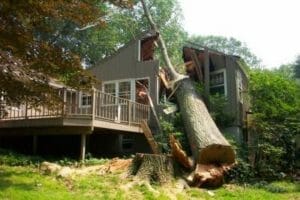Do you consider yourself self-reliant, or at least try to be in as many situations as possible? It’s great to have an independent, do-it-yourself, spirit. However, sometimes the best option is to enlist the help of others. Such is the case with tree removal.
Most of us have seen viral videos of hapless homeowners cutting down trees, only to see them fall in a direction they did not intend, most often towards their homes. Sometimes it’s carelessness, other times it’s well-intentioned people making costly mistakes. While we poke fun at these people, the results are no laughing matter.
Leave the Risk-Taking to the Pros
Tree cutting is dangerous, even for those who make a living doing so. Professional are injured every day. According to the Tree 
Care Industry Association, there were 84 fatalities in 2012. Of the fatalities reported to the Census of Fatal Occupational Injuries from 1992 to 2007, the average annual rate was 80 deaths.
Another reason it’s wise to defer to a professional arborist is avoiding the legal liability if an accident occurs. If you damage a neighbor’s property, or worse, injure someone, you are on the hook. A licensed and insured arborist takes this potential burden away from you.
In addition to the skills unique to trained tree care professionals, there is specialized equipment that homeowners are not likely to have. Even if you had the skills to do the job, it would not make financial sense to buy or rent this equipment for one-time use.
Then there are proper techniques for “limbing” the tree once it’s down. The potential for danger is not gone after the tree is horizontal. Improper cutting of limbs can lead to injuries, such as the tree rolling on you when picking the wrong branch to cut. Then there’s a stump that needs to be removed.
Even if you think you are cutting at the right angle, that’s not a guarantee it will fall in the direction you expect, since there are a number of other considerations that need to be accounted for. Of course, proper tree removal is so much more than cutting at the perceived right angle. There’s an “undercut” and a “backcut.” Techniques are tailored to the tree’s condition, weather conditions, the surrounding landscape, and much more.
Professionals go through this process and use the potentially dangerous tools all the time. Risks are not always easy to identify, so familiarity and expertise almost always trump well-intentioned do-it-yourself ambition. If you have a tree you need removed from your property, give us a call today.
This post first appeared on https://www.urbanforestprofessionals.com